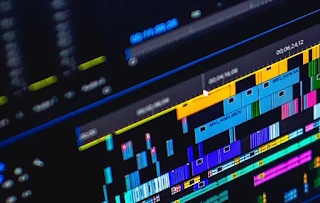Editing Blog number one reference: Laying groundwork for scenes and doing audio!
Hello there my enthusiastic friends! In today's blog I will be discussing how the editing process went. For the editing, Peyton wanted to split it up into two sessions: Scenes and audio, and titles and miscellaneous- but equally as important- elements. So, because the titles cannot go on without a base, she began promptly on putting the scenes together. She began this process by inserting the beginning five scenes so as not to overwhelm the timeline yet. These were the skipping, pool, bedroom, chalk, and picture wall scenes. She clipped the edges off the skipping's back-facing shot so that the middle part with maximum movement and easy continuation into the front-facing shot would remain. She repeated this process with the front-facing clip and played it to make sure the clips connected well, which they did. For both clips, I liked the diegetic sounds of the environment and their movement, so she did not fully lower the volume on them. Next, she moved on to the pool scene where, here, the diegetic sounds were very overwhelming, so she had to turn the audio down completely. So that this clip did not look stagnant, she clipped it to show just the part with maximum movement, which was Riley and me trading their toys. The hair braiding bedroom scene was next, and for this scene, Peyton wasn’t sure of how much she liked the lighting and the lack of movement. For this, I asked for feedback from my group but I was told that they thought it was fine the way it was, and after brightening it up a bit and moving around the frame of the clip which was shown, she eventually came to the same consensus.
Moving to the next scene she added, which was the chalk, she had a bit of a harder time with this one. The clip was really lengthy, but cutting it at any point in the movement made it look very harsh and choppy. She experimented with a few different speed settings, and the least noticeable one with the most effect was the speed setting 1.6. It’s not much, but it sped the clip up just enough to include most of it in there without it being too harsh of a cutoff. The wall montage was then added, but she did not like how it went by so quickly. Peyton knew she wanted to add words here eventually, so with the quickness of it, it would look too blurry and busy. To fix this issue, she went to the speed tab and instead of choosing a normal preset option, she chose curve. Curve allows you to manipulate the speeds at certain times, which she had figured out by dragging around the dots and seeing its consequences. Peyton dragged the curve down in the middle of the clip, right when the camera is on the pictures so that it lingers there long enough to make the pictures visible, and the words would look right. She then split the scene of Marissa and Riley walking up to the front door into bits, creating a jump cut. She was eager to include this style of editing since, first off, I personally find it really cool and fun to watch, and secondly, because it is quite common in thrillers to create a sense of urgency and disorientation.
For the beginning couch scene, all we had to do was cut off the beginning part of Riley and Marissa laughing then getting in to character. She inserted the next six scenes into the timeline, and again, it was rinse and repeat. To keep up the compromise between both of our songs that she proposed earlier, Peyton started out by inserting both the Lullaby and the Tiny Tim song and shifting the Lullaby to the end and out of the way while I worked with the Tiny Tim song for the kid scenes. I had this song playing from the start to a bit past the beginning of the first couch scene where the audio began, to which it would then switch to the instrumental version. Here, I used to keyframes to adjust the audio level as specific points, or have the volume fluctuate over certain intervals. I did this when the transition for the wall of pictures showed up so that it was a more gradual change to the diegetic sounds of the driveway. She then added a fade-out effect of 3 seconds and another keyframe at the very end of the audio segment to have the audio fade out more gradually, and end at a lower sound, since if she only used the fade-out effect, it would fade to zero, and then it wouldn’t transfer seamlessly to the instrumental version. This was the first part of a lengthy and tedious process. Thats all for today! The journey isn't over yet but it is soon. Till next time my enthusiastic friend's!

.jpg)


Comments
Post a Comment